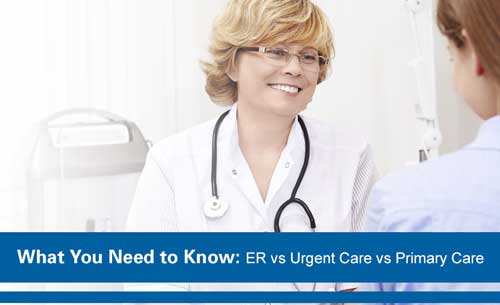What You Need to Know: ER vs Urgent Care vs Primary Care
Apr 20, 2016
When you’re sick, it’s hard enough to function, much less try and decide where to go see the doctor. From Urgent Care clinics to the Emergency Room to your primary care physician, there are plenty of options – but where should you go?
Skye Vise, one of our Nurse Practitioners, broke it down for us so you don’t have to worry the next time you or a loved one is sick.
The main difference amongst your options is the level of care they provide. Each has their benefits, so making sure you chose the right care setting is important.
Emergency Room
“The ER should be reserved for life-threatening emergencies or acute complications that need advanced imaging,” Vise said. It’s the best place to go for signs or symptoms of a heart attack, stroke, or traumatic injury.
In addition to symptoms of a stroke or heart attack, you should go the Emergency Room if you have an acute trauma that includes the risk of a loss of limb, motor vehicle accidents, broken bones, major head injuries, seizures, severe abdominal pain, severe asthma attack, unconsciousness, or uncontrollable bleeding. The ER will be able to provide the advanced care you need, in a time-aware environment.
The down side to going to the ER is something many people know – wait times. (At some BBH hospitals, you may have the option to wait from home, instead of the ER, by checking in online. This can greatly reduce the time that you spend in the ER by allowing you to wait at home.)
“ER visits should be used for those who are acutely ill. When ER’s are flooded with non-emergent issues, wait times are often longer.”
Urgent Care
“Urgent care centers are useful options when you don’t have a primary care physician, or your doctor is unavailable due to it being after-hours or on a weekend. They’re also good when you are unable to make a timely appointment, or when you require medical attention for an acute but not life threatening emergency such as a sprained ankle,” Vise says.
Urgent care visits can be utilized for common cold symptoms such as cough, nasal drainage, sore throat, and ear pain. Other conditions treated include rashes, minor cuts/lacerations, nausea/vomiting, urinary tract symptoms, minor sprains and strains, minor burns, insect bites, migraines, and dehydration. If your injury or illness is more serious, go to the ER.
While urgent care facilities are a good resource for illnesses and medical issues that arise after hours and on the weekends, you should still follow up with your primary care physician after your urgent care visit to ensure your health is restored. You should always update your primary care provider on any health changes.
Primary Care
“Primary care physicians treat lifelong complications such as hypertension and diabetes and minor ailments such as colds,” Vise said. “The benefit of visiting your primary care physician when you are sick is that the physician will know your medical history, any allergies to medications, understand what new medications will work best with your current medications, and many times are able to accommodate you when you need a sick visit.”
“They will pick up on small changes in your health before another provider because they already established a base line from your yearly checkups.” This means they can notice changes before others can, and can be instrumental in helping you stay healthy.
Primary care appointments are also the most cost effective.
It is ideal to establish care with a primary care physician so that they can get to know you and your medical history. Not only does a primary care provider care for acute and chronic illnesses such as diabetes, they also provide health education, routine checkups, overall health management, and promote health prevention throughout the life span of the patient.
A primary care physician cares for acute illnesses, chronic conditions, promotes health, and coordinates preventive health screenings. Acute illnesses include common cold symptoms, rashes, minor cuts/lacerations, nausea/vomiting, urinary tract symptoms, minor sprains and strains, minor burns, insect bites, and migraines. Chronic conditions are illnesses such as hypertension, diabetes, cholesterol, depression, anxiety, asthma, COPD, and thyroid disorders.
Health promotion consists of yearly checkups, education on nutrition and weight loss, directions on medication use. Primary care physicians can easily coordinate preventive health screenings such as routine lab work, eye exams, colon screenings, and mammograms.
